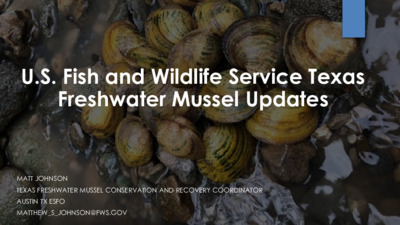20240918-004: Listing status of native mussels FWS presentation — original pdf
Backup

U.S. Fish and Wildlife Service Texas Freshwater Mussel Updates TEXAS FRESHWATER MUSSEL CONSERVATION AND RECOVERY COORDINATOR MATT JOHNSON AUSTIN TX ESFO MATTHEW_S_JOHNSON@FWS.GOV General Central Texas Freshwater Mussel Ecology Occupy freshwater rivers, creeks, and streams Inhabit streambeds consisting of mixtures of bedrock, cobble, gravel, sand, and silt Require a host fish to complete their unique reproductive cycle. Mussels can be host fish specialists or generalists. Require stable habits and adequate water quantity and quality: Pollution Appropriate Temperatures Instream Flows G. Pandolfi - FWS Habitat Requirements Substrate Suitable substrate requirements vary by species root wads Cobble, gravel, sand, silt – Stability! Some species will utilize undercut banks or Water Flow/Quantity Appropriate Flow Regime Flow Refugia – area of stream bed that is not mobilized during high flooding events Water Quality – Pollution, ammonia, turbidity, conductivity, etc. Water Temperature – behavior, feeding rate, dissolved oxygen consumption and reproduction are all tied to temperature Freshwater Mussel Habitats Primary Threats Habitat Alterations Flow alteration and decline (water quantity) Sediment accumulation Reduced water quality Fish barriers Overcollection Ammonia Freshwater Mussel Ecosystem Services Texas Freshwater Mussel Conservation History 2007 – Suite of mussel species petitioned for listing under the ESA 2009 – USFWS issued a positive 90-day finding for most of the petitioned species 2009 – TPWD listed 15 species as State-Threatened 2011 – 12-month finding determined listing was warranted but precluded by other activities Resulted in mussel species being added to the Candidate List Species placed into listing work plan to be completed between FY20 and FY22. The Service created several Species Status Assessment (SSA) packages to review the status of selected freshwater mussel species across the state. SSA information is presented to a Recommendation Team where policy is applied to the best available science to reach a listing recommendation. The listing recommendation is then made to the Regional Director who decides if they approve or disapprove of the recommendation. What Actions did the Service Take? On August 26, 2021, the Service proposed: The listing of 5 freshwater mussels as Endangered with associated Critical Habitat The listing of 1 freshwater mussel as Threatened with a 4(d) rule and associated Critical Habitat Proposed critical habitat in 27 units (1,944 river miles total) On June 4, 2024 (and effective July 5, 2024), the Service listed: Listed 6 species as Endangered with associated Critical Habitat Listed 1 species as Threatened with a 4(d) rule and associated Texas fatmucket (Lampsilis bracteata) Critical Habitat Designated habitat in 20 units (~1,053 river miles total) What are the listed species designations? Endangered Species – a species which is in danger of extinction throughout all or a significant portion of its range. These species receive all ESA legal protections. Threatened Species – any species likely to become an endangered species within the foreseeable future throughout all or a significant portion of its range. These species receive tailored ESA legal protections through a Section 4(d) rule. What is Critical Habitat? Critical habitat identifies geographic areas that are essential to the conservation of federally listed threatened or endangered species and include necessary Physical and Biological Features A riverine system with habitat to support all life stages of the species, which includes: (a) Suitable substrates and connected instream habitats (b) Adequate flows (c) Adequate water and sediment quality (d) Identified host fish present Federal agencies are required to consult with the USFWS when they undertake, fund, or authorize any activity that may affect the species or critical habitat. Critical habitat DOES NOT affect land ownership or establish a refuge, wilderness, reserve, preserve, or other conservation area. Unit TXFM-6: Onion Creek The Onion Creek unit consists of 23.5 river mi (37.8 river km) in Travis County, Texas. Unit TXFM–6 begins at the Interstate Highway 35 bridge crossing downstream to the confluence with the Colorado River. This unit combines the proposed Lower Onion Creek (TXFM– 6a) subunit and the proposed Upper Onion Creek (TXFM–6b) subunit. This unit was consolidated due to recent survey data confirming that Texas fatmucket inhabit Upper Onion Creek, which had been thought to be unoccupied. Critical habitat restricted to within the Ordinary High- Water Mark of the stream but impacts outside of this boundary can be considered. What protections do listed species have? • Under section 9 of the ESA, it is illegal to import, export, or take endangered species for any purpose, including commercial activity unless authorized under Section 10 of the Act. Take = kill, hunt, shoot, wound, trap, harm, harass, collect Impacts to instream habitats via construction, sedimentation, flow alteration, etc. also now need to be reviewed through the consultation process when appropriate. Questions? Texas Freshwater Mussel Conservation and Recovery Coordinator Matt Johnson Austin TX ESFO Matthew_S_Johnson@fws.gov